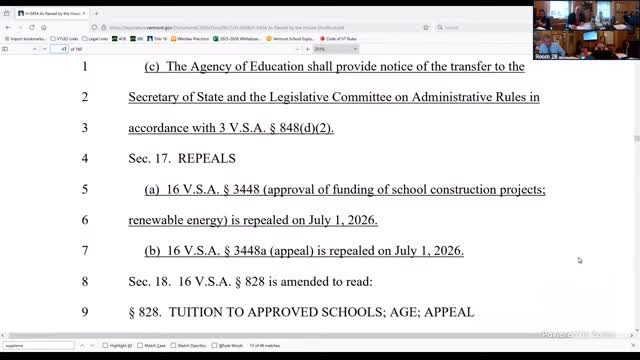
This article was created by AI using a video recording of the meeting. It summarizes the key points discussed, but for full details and context, please refer to the video of the full meeting. Link to Full Meeting
One of the key amendments discussed was to Section 828 of Title 16, which outlines the types of educational programs for which school districts can pay tuition. The new regulations specify that tuition can only be paid to public schools located in Vermont and to approved independent schools that meet certain criteria. These criteria include being approved under section 166 of the title before the effective date and having at least 51% of their student enrollment funded by district tuition. This change aims to clarify the distinction between "approved" and "recognized" independent schools, with the latter not being eligible for tuition payments.
Additionally, the meeting addressed provisions for schools that may struggle to meet minimum class size requirements due to geographic isolation. Such schools can apply for a waiver from the state board, ensuring that they can still participate in the tuition program under specific conditions.
Another important aspect discussed was the "tuition transition" provision, which allows students currently enrolled in independent schools to continue receiving tuition payments until they graduate, even if their school does not meet the new eligibility standards. This provision is crucial for students who are already in the system, ensuring continuity in their education.
The meeting also touched on the inclusion of therapeutic approved independent schools, which cater to students with specific educational needs, such as those on Individualized Education Programs (IEPs). This recognition reflects a growing awareness of the diverse educational requirements within the student population.
In conclusion, the amendments discussed during the Senate Education meeting represent a significant shift in Vermont's approach to funding independent education. By tightening eligibility criteria and providing transitional support for current students, the state aims to enhance the quality and accountability of educational programs while ensuring that students' needs are met. As these changes are implemented, stakeholders will be closely monitoring their impact on the educational landscape in Vermont.
Converted from Senate Education 2025-04-18 1:15PM meeting on April 19, 2025
Link to Full Meeting
Comments
View full meeting
This article is based on a recent meeting—watch the full video and explore the complete transcript for deeper insights into the discussion.
View full meeting

